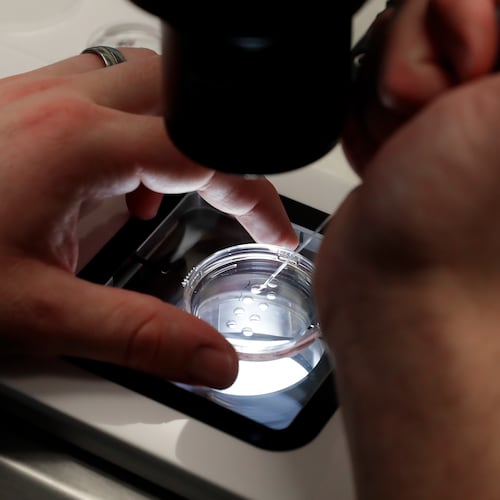Nearly 500 people crowded a high school auditorium near Lilburn that night and, for three hours, yelled and clapped and jeered and booed before the public officials who'd come to hear their thoughts on a proposal for Gwinnett County to join MARTA.
It was a pivotal moment, the fate of public transportation in the fast-growing county — nay, the fate of Gwinnett itself, some said — hanging in the balance.
What unfolded from the podium that July evening in 1990 exposed raw views on race in a suburban community that was mostly white, as well as a broad distrust of linking Gwinnett’s future to Atlanta.
“That place,” one man said, referencing the state’s capital, “has a reputation for murder and rape — the wrong people. We don’t need ‘em, we don’t want ‘em.”
Said another: “Do we really want a direct line for the drug dealers at Five Points to get new markets among our fourth- and fifth-graders?”
Three months later, Gwinnett voters roundly said no to joining MARTA. It would be nearly three decades before they’d be asked to join the system again — and as the county barrels toward that new referendum on March 19, advocates have looked to the past to try to avoid its pitfalls.
AJC FLASHBACK PHOTOS
Gwinnett in 1990 was just starting to sow its oats as a regional powerhouse after a decade of rapid growth from a once rural county to a suburban hotspot. Its iconic I-85 water towers — "Gwinnett is Great" and "Success Lives Here," they read — were as much an admonition of Atlanta as they were a praise of one of the country's fastest-growing communities. But all those newcomers quickly pushed the county's transportation needs of the future to the forefront. A county task force and then a group of consultants recommended considering public transportation.
The county did. But the effort was ill-fated.
Mass transit was an exotic pitch to many Gwinnett residents three decades ago, regardless. But the plan was simultaneously ambitious and slapdash. And the raucous meeting near Lilburn was the only public hearing on an issue in which the vote was rushed.
Said Emory Morsberger, a longtime Gwinnett developer who would later serve on MARTA’s board of directors: “I don’t think it was taken very seriously.”
‘A nebulous promise’
Gwinnett County manager Chuck Button received a clear directive from his bosses.
The all-white, Republican-dominated county commission told him to begin negotiations with the MARTA board for a service plan. It was June 1990 and he was ordered to have it done within 90 days.
Completed a few weeks later, it was presented to the commission, which greenlighted the call for a countywide referendum. It was the second time in 19 years that county voters would be asked if they wanted to join the transit agency; the first referendum in 1971 failed in Gwinnett. But agency and county had both changed dramatically in the intervening two decades, and advocates for mass transit were hopeful.
Gwinnett had grown to around 350,000 residents. And MARTA had expanded its rail service in Fulton and DeKalb counties.
Still, there were warning signs that the political environment was not ripe. Just the year prior, residents had caused a ruckus after county leaders flirted with allowing MARTA to run express commuters buses into Gwinnett.
"One of the worst fears," then-Commissioner W.J. Dodd told the Associated Press decades ago, "is bringing people out of Atlanta, the minorities."
Even putting racial tensions aside, transit in the Atlanta suburbs proper was still a novel idea.
In 1990, Chamblee in north DeKalb and Avondale just one stop east of Decatur were the MARTA rail stations closest to Gwinnett. The Doraville station — which many Gwinnett residents use today — was not yet open.
Nor were Kensington and Indian Creek, the east-west line stations now closest to southern Gwinnett. The entire MARTA branch that extends from Lindbergh Center north, into the Dunwoody and Sandy Springs areas, did not exist either.
Gwinnett was a prospering, conservative northern suburb that, to borrow the subtitle of one local historian’s book, fancied itself “a little above Atlanta” in more ways than one.
Despite all that — and despite the fact that then-Commission Chairman Lillian Webb was about the only true, high-profile transit advocate around — the county and MARTA moved forward with crafting a plan.
It was about five weeks after the commission gave the go-ahead on negotiations that the plan emerged. It involved a 10.8-mile rail line to Gwinnett Place Mall (then a local retail jewel), 11 express bus routes and van service for the elderly and handicapped. In exchange, Gwinnett taxpayers would pay a 1 percent sales tax to fund MARTA’S expansion.
Ambitious as it was for the time, there were no real guarantees involved.
‘Connected in every possible way’
As the referendum approached, the sense in political circles was that transit advocates were facing an uphill battle to win the day.
Then, at 5 p.m. on Nov. 6, 1990 — the day before Election Day — a northbound tractor-trailer jackknifed on I-85 near Pleasant Hill Road. It spilled sand and diesel fuel into the southbound lanes. Three cars caught fire.
Traffic backed up along the interstate for six miles and it took hours to clear. Could such a catastrophic traffic event change the tide?
“All across Gwinnett,” the AJC’s transportation reporter, Doug Monroe, later wrote, “dinners were growing cold and radiators were growing hot. And, perhaps, some people were changing their minds.”
As it turns out, that was not to be, at least in any meaningful way.
The vote the next day failed miserably, so much so that MARTA would remain an all-but-untouchable subject in Gwinnett County for nearly three decades. Roughly 70 percent of voters cast ballots against the measure.
Current commission chair Charlotte Nash knows the problems of that vote 29 years ago.
A lifelong Gwinnett resident, she was the county’s financial services director back then.
“I voted against it because there was a nebulous promise about what we would get as a result of it,” she said.
She is largely responsible for Gwinnett having a vote on MARTA this time around — and the lessons of yesteryear have stuck with Nash during the current push, for better or for worse.
There is no rush this time around. The county spent nearly two years devising the plan that would guide Gwinnett's transit future if the referendum is approved — it includes not just a roughly four-mile rail extension into the Norcross area but a bus system with extensive, diverse options. The pending contract between Gwinnett and MARTA gives the county an unusual amount of control over finances and projects. And the actual ballot question voters will confront doesn't mention MARTA by name.
Still, the timing and politics could again thwart the proposal.
The referendum voters will consider would've had a better chance of passing if it had been added to ballots during November's mid-term election. Even with three weeks of early voting that start Feb. 25, the vote this year will undoubtedly have lower turnout and makes MARTA's proposal a much more tenuous proposition.
Still, advocates hope the Gwinnett of today will make the difference. It's a community whose nearly 1 million people are among the most diverse in the Southeast. And as that population expanded, the endless construction of roads has done little to soften traffic.
“Gwinnett used to be somewhat insular. And now, Gwinnett is connected in every possible way,” said Morsberger. “It’s connected to Atlanta, it’s connected to the rest of the state and it’s connected to the world.”
AJC’s COMPLETE COVERAGE
Gwinnett voters will go the polls on March 19 in a historic special election that could change the face of metro Atlanta’s suburbs.
Residents there will decide if Georgia’s second most populous county will join the MARTA system and chip in a new 1 percent sales tax to pay for billions of dollars in transit improvements. A successful referendum in Gwinnett may ignite action for more mass transit in other metro Atlanta counties that have long been resistant to the idea.
The Atlanta Journal-Constitution will provide comprehensive coverage leading up to the vote and on Election Day. Our reporters will help readers understand the issues, the key players, what’s at stake, and provide information for voters to make an informed decision at the ballot box.
GWINNETT’S 2019 MARTA REFERENDUM
The ballot question: "Voters will see the ballot question phrased this way when they visit the polls: "Gwinnett County has executed a contract for the provision of transit services, dated as of August 2, 2018. Shall this contract be approved? YES __ NO __"
What it means: A yes vote would be a vote in support of ratifying Gwinnett's pending transit service contract with MARTA, allowing it to take over Gwinnett's current transit services and greatly expand them — including a possible rail extension into the Norcross area and an extensive bus system with diverse options.
A yes vote would also trigger a new 1 percent sales tax to pay for such projects. Purchases in Gwinnett are currently subject to 6 percent sales tax. The new countywide sales tax would remain in effect until 2057 and garner billions of dollars. Collected funds would be remitted to Gwinnett County, which would then write checks to MARTA for projects and operations.
Key dates: Election Day is March 19.
Advance in-person voting will be held at the Gwinnett elections office (455 Grayson Highway in Lawrenceville) every day between Feb. 25 and March 15, including weekends.
Between March 4 and 15, advance in-person voting will also be held at several satellite locations. Those can be found at gwinnettcounty.com.
Hours are 7 a.m. to 7 p.m.
About the Author
Keep Reading
The Latest
Featured







